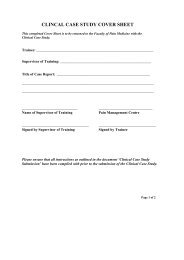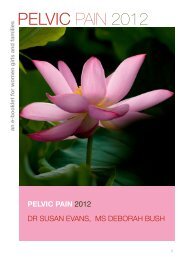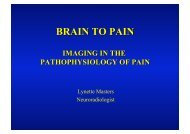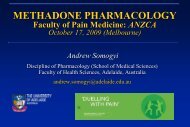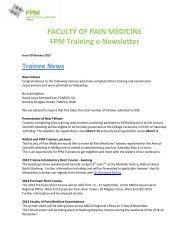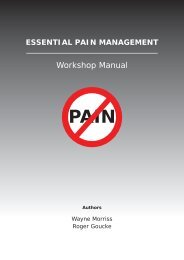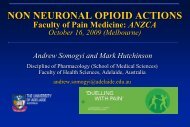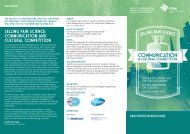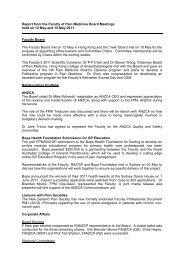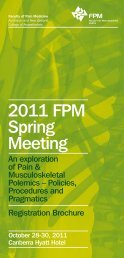Clinical case study assessment - Faculty of pain medicine
Clinical case study assessment - Faculty of pain medicine
Clinical case study assessment - Faculty of pain medicine
Create successful ePaper yourself
Turn your PDF publications into a flip-book with our unique Google optimized e-Paper software.
1FACULTY OF PAIN MEDICINE, ANZCA<strong>Clinical</strong> Case Study AssessmentThe Standard is that expected <strong>of</strong> a Specialist Pain Medicine Physician.The Case Study is to be marked with reference to FPM Document “Preparation <strong>of</strong> the Case Study”. Where justification is required, this is to beprovided by the Candidate.The manuscript submitted by Trainees is assessed against the Case Content and Generic Criteria stated in the Learning Objectives presented inthe Preparation <strong>of</strong> the Case Study.The outcome <strong>assessment</strong>s are satisfactory performance, borderline performance or unsatisfactory performance. As with a journal, everycomponent <strong>of</strong> the <strong>assessment</strong> must achieve a standard <strong>of</strong> satisfactory performance, consistent with the reality that Trainees are not limited bytime or access to support or resources, in writing or revising the manuscript.Assessment Criteria applied to each Case Component listed:The Case Study <strong>assessment</strong> is broken down into Case Content components. Each Case Content component is assessed against the GenericCriteria below.Each Criterion for each Case Content Component is assessed as being met to a satisfactory, borderline or unsatisfactory standard.Whether a Criterion meets a satisfactory, borderline or unsatisfactory standard depends on to the extent to which the material presentedrepresents safe and effective patient care and demonstrates the Trainee’s understanding <strong>of</strong> the patient’s predicament and management.For example, if the material presented is deficient – or if the clinical reasoning is deficient -and incorrect conclusions reached, this may havethe effect <strong>of</strong> altering a diagnosis or problem formulation and ensuing management; thus there is a potential effect on safe and effectivepatient care.FPM Examination Committee 12 August 2012
2GENERIC CRITERIA:1. Communicates effectively in written English language, including adequate editing (pro<strong>of</strong>-reading for spelling, punctuation, absence <strong>of</strong> abbreviationsand appropriate de-identification).2. Presents accurate and original work.3. Presents information in a sequence that develops the Case.4. Demonstrates effective judgment in selecting <strong>of</strong> patient related data.5. Demonstrates effective judgment in the selection <strong>of</strong> scientific literature.6. Demonstrates effective skills in integrating patient data with scientific literature.7. Demonstrates effective clinical reasoning, analysis and judgment.8. Demonstrates appropriate judgment in presenting pr<strong>of</strong>essional opinions.CASE COMPONENT CRITERIA:1. Satisfactory: Provides all positive and negative information that is relevant. Analyses that information and demonstrates its relevance to the patient and her/his predicament Provides an integrated discussion that draws on support from the scientific literature and further demonstrates the relevance <strong>of</strong> thatinformation to the Study. The language used is clear, pr<strong>of</strong>essional, appropriate and concise and the topic is approached in a structured, systematic manner and thediscussion is relevant to the <strong>case</strong>2. Borderline: Does not provide all the relevant data expected from an <strong>assessment</strong> Little analysis <strong>of</strong> the data and its relevance to the patient and his/her predicament Makes an attempt to provide an integrated discussion using the scientific literature, however, the relevance <strong>of</strong> the information remainsuncertain. The language used is occasionally unclear or unnecessarily extended and or the approach to the topic is confusing and or the discussion isnot relevant to that section3. Unsatisfactory: Provides non-specific and or inadequate information related to the patient Does not consider or analyse that information and or relate it to the patient and her/his presentation Does not provide an effective integrated discussion and or does not effectively use the scientific literature.FPM Examination Committee 12 August 2012
3The language used is generally unclear, less precise or pr<strong>of</strong>essional and may be inappropriate and or the topic approach is not structuredand systematic or irrelevant.EXAMINER MARK SHEETCase component Assessment Reasons for <strong>assessment</strong>:comment, examplesfeedback for revision1. ASSESSMENT Consider the following question in assessing the next areas.Does this <strong>case</strong> include a thorough, comprehensive history in the standard format including discussion<strong>of</strong> the referral, history <strong>of</strong> presenting complaint, <strong>pain</strong> history, past medical history etc. as relevant?History <strong>of</strong> the patient with PainSee Trainee Support Kit 5.2.1(Includes demographics, referralhistory and patient perspective)SatisfactoryBorderlineUnsatisfactoryHistory <strong>of</strong> the PainSee Trainee Support Kit 5.2.1(Includes events, attribution,characteristics, timing,aggravating, alleviating andassociated features)Biological historySee Trainee Support Kit 5.2.1SatisfactoryBorderlineUnsatisfactorySatisfactoryBorderlineFPM Examination Committee 12 August 2012
4(History <strong>of</strong> the patient in PainHistory <strong>of</strong> the patient with Pain)UnsatisfactoryConsider the following questions in assessing the next areas.Are the personal and developmental histories sufficiently detailed to substantiate the proposedpsychological aspect <strong>of</strong> the formulation?Is the social history sufficiently detailed to substantiate the proposed contribution <strong>of</strong> thefamily/vocational/social groups to the proposed social aspect <strong>of</strong> the formulation?Psychological historySee Trainee Support Kit 5.2.1(History <strong>of</strong> the patient in PainHistory <strong>of</strong> the patient with Pain)SatisfactoryBorderlineUnsatisfactorySocial historySee Trainee Support Kit 5.2.1(History <strong>of</strong> the patient in PainHistory <strong>of</strong> the patient with Pain)ExaminationPain oriented physical examinationOther physical examinationMental state examinationSatisfactoryBorderlineUnsatisfactorySatisfactoryBorderlineUnsatisfactoryConsider the following questions in assessing the next areas.Has a comprehensive physical examination been conducted with emphasis relevant to the person?Is there adequate discussion around the collection <strong>of</strong> further information, including investigations?Has a thorough and comprehensive mental status examination been conducted with emphasisrelevant to the person with the <strong>pain</strong> problem?FPM Examination Committee 12 August 2012
5Functional examinationInvestigationsSatisfactoryBorderlineUnsatisfactory2. FORMULATION Consider the following questions in assessing this area.Were the diagnosis and differential diagnosis made using a recognised classification system?Has a sophisticated biopsychosocial formulation been included, developed at the time that therapywas initiated so that this can be reflected upon during the course <strong>of</strong> the therapy and modified withincreasing experience and knowledge <strong>of</strong> the person with the <strong>pain</strong> problem?Diagnostic Impression andCase FormulationSatisfactoryBorderlineUnsatisfactory3. MANAGEMENT PLAN ANDCLINICAL PROGRESSConsider the following questions in assessing the next areas.Does the management plan demonstrate that the trainee has considered all <strong>of</strong> the relevant biological,psychological, social, spiritual and cultural issues?Does this <strong>case</strong> include discussion <strong>of</strong>: the way in which therapy was negotiated with the person with the <strong>pain</strong> problem? the suitability <strong>of</strong> the type <strong>of</strong> therapy for the person with the <strong>pain</strong> problem? other treatment modalities which were considered and the reasons for their rejection?FPM Examination Committee 12 August 2012
6 the potential risks <strong>of</strong> the chosen therapy? goals and expectations <strong>of</strong> the person with the <strong>pain</strong> problems and the therapist? awareness <strong>of</strong> any limitations <strong>of</strong> the therapies usedHas the involvement with other health pr<strong>of</strong>essionals, <strong>case</strong> managers, etc. been detailed and theissues around this fully explored and discussed?Has there been a review <strong>of</strong> the progress <strong>of</strong> the person with the <strong>pain</strong> problem and a clear description<strong>of</strong> the processes that were observed and experienced?Has the trainee demonstrated and discussed his/her communication with other pr<strong>of</strong>essionals who areor will be working with the person with the <strong>pain</strong> problem?Goals <strong>of</strong> managementManagement planRisk managementPlan ImplementationMultidisciplinary team approachto, and its application in practiceSatisfactoryBorderlineUnsatisfactoryPrognosisFollow UpProgress andOutcomesMultidisciplinary team approachto, and its application in practiceSatisfactoryBorderlineUnsatisfactoryFPM Examination Committee 12 August 2012
74. DISCUSSION Consider the following questions in assessing this area.Has the discussion evaluated the therapy and its significance for the person?Has the discussion placed this therapy/therapies in the context <strong>of</strong> the theory underpinning the model<strong>of</strong> therapy/therapies and reflected on this?Is the discussion reflective and as appropriate, critical <strong>of</strong> the existing theoretical knowledge?Is the discussion correctly referenced according to a standard format?Discussion <strong>of</strong> significant issueshighlighted by this <strong>case</strong>SatisfactoryBorderlineUnsatisfactoryAppropriate use <strong>of</strong> references andsatisfactory referencing systemSatisfactoryBorderlineUnsatisfactoryOverall Comments:………………………………………………………………………………………………………………………………………………………………………………………………………………………………………………………………………………………………………………………………………………………………………………………………..............................................................................................................................................................................................................................................................................................................................................................................................................................................................................................................................................FPM Examination Committee 12 August 2012
8The submitted <strong>case</strong> history has been evaluated on the criteria detailed on this Examiner Mark Sheet.Where the standard <strong>of</strong> performance in any component is judged by the expert Examiner to be borderline or unsatisfactory, it is expected that Trainees willreceive specific feedback, with concrete examples, that illustrate the reasons for that decision.The Examiner’s feedback is included in a letter prepared by the staff <strong>of</strong> the <strong>Faculty</strong> <strong>of</strong> Pain Medicine, and sent to the Trainee by the Case Study CoordinatingExaminer.If the Case Study does not meet the required satisfactory standard, the Examiner will provide sufficient feedback to guide the development <strong>of</strong> the CaseStudy by the Trainee. However this is not intended to be a step-by-step guide to rectify the <strong>case</strong> and other aspects may need your consideration. It is notedthat on some occasions other sections <strong>of</strong> the <strong>case</strong> will be substantially affected by the rewriting. Changes made willneed to be reflected consistently throughout the <strong>case</strong>.Once it has been revised, the Case Study may be resubmitted by the trainee. The <strong>case</strong> will be re-marked as a whole following the above process. This cyclemay be repeated more than once.In some instances, examiners may advise candidates that the failed <strong>case</strong> is unsuitable for re-submission and a new <strong>case</strong> will need to be submitted.Examiner’s recommendation:o Satisfactory performanceo Requires revision and resubmission____________________________________________Signature (Print surname)___________________________DateFPM Examination Committee 12 August 2012



